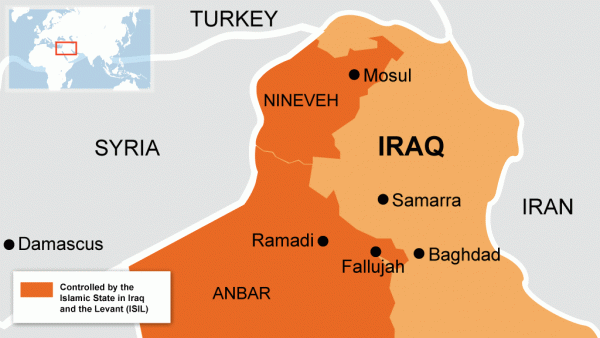 A year after ISIL fighters captured Fallujah in Iraq’s Anbar province, the country’s Shiite-led government remains incapable of mounting a major offensive to retake the city or any of the key areas still held by the group.
A year after ISIL fighters captured Fallujah in Iraq’s Anbar province, the country’s Shiite-led government remains incapable of mounting a major offensive to retake the city or any of the key areas still held by the group.
In January last year, Fallujah, 70 kilometres west of Baghdad, became the first major city to fall to ISIL. This was followed by a summer campaign that seized the country’s second-largest city, Mosul, and Saddam Hussein’s hometown of Tikrit, along with most of northern and western Iraq.
Iraq’s military has made a partial recovery following its collapse in the face of ISIL’s summer blitz. With the aid of US-led air strikes, it has now recaptured large areas of territory in Diyala province, north-east of Baghdad, as well as the Jurf El Sakhr region, south-west of the capital.
In November, Lieutenant General Abdul-Wahab Al Saadi — recognised as one of the best generals in the Iraqi army — led some 250 men on a 30-day campaign that liberated Beiji, a city and oil refinery north of Baghdad. But ISIL fighters have since returned to the city’s suburbs, raising fears that the group could take Beiji back.
Iraq’s slow-moving fight against ISIL has also highlighted the country’s sectarian tensions, given Iran a key role in military operations, and laid bare the country’s love-hate relationship with the United States, whose troops only withdrew from Iraq in 2011 after invading eight years before.
Sunni-Shiite tensions have gripped Iraq since the US toppled Saddam Hussein in 2003 and violence between the two communities peaked in 2006 and 2007, with thousands of killed in tit-for-tat attacks. The tension had eased somewhat by 2008, but exploded again when ISIL began its offensive in Anbar province in late 2013.
A call for jihad by Iraq’s top Shiite cleric following the fall of Mosul in June saw hundreds of thousands of Shiite youths signing up to fight ISIL, giving the war a distinct sectarian slant. Later, the government created a state agency to look after the affairs of the volunteers — the Popular Mobilization Authority — a sort of clearing house for all non-governmental fighters. The authority allowed Iranian-backed militias with a track record of sectarian violence and anti-American attacks to win a measure of official recognition as well as access to state funds and weapons, just like the volunteer fighters.
The prominent fighting role given to the Shiite volunteers and militiamen led to abuses like extrajudicial killings and theft that Iraq’s top Shiite cleric, Grand Ayatollah Ali Al Sistani, publicly condemned. His appeals for discipline, however, have failed to stop the volunteers and militiamen from quietly carrying out sectarian cleansing. The groups have tried to diminish or even uproot Sunni communities in areas close to roads leading to major Shiite shrines, north and south of the capital.
Their methods include preventing Sunnis from returning to their homes in areas taken back from ISIL or applying scorched-earth tactics that leave the residents with nothing to go back to. Sunnis who stayed put and endured ISIL rule are often charged with collaborating with the extremists when their areasare retaken.
These practices have led to protests by Sunni politicians, who argue that sectarian cleansing has been carried out in Diyala province, which has a mixed population of Sunnis, Shiites and Kurds, as well as areas close to the major Shiite shrine in Samarra, north of Baghdad, and in areas to the south and south-west of the capital.
Iraq’s Shiite prime minister, Haidar Al Abadi, who had been in office since August, has been forceful in speaking out against sectarianism and has repeatedly called for the residents of Sunni areas liberated from ISIL control to be allowed to return to their homes. Mr Al Abadi’s stance is a far cry from that of his predecessor Nouri Al Maliki, whose eight years in office were defined by his sectarian policies and his going after top Sunni politicians over terror-related or corruption charges. It is still too early to see whether Mr Al Abadi will go beyond simply paying lip service to national unity, however.
The fight against ISIL has also allowed Iraq’s larger and more powerful neighbour, Iran, to gain an even bigger foothold in the country. The commander of Iran’s elite Quds Force, the foreign arm of its Revolutionary Guard, is directing the fight on multiple fronts, aided by Shiite Iraqi militiamen. Military advisers from Lebanon’s Iranian-backed Hizbollah are also in Iraq, working under the leadership of the Quds Force commander,Major General Qassem Suleimani.
Meanwhile, many in Iraq — including politicians, generals and tribal leaders — have voiced their disappointment with the US’s role in the war against ISIL. They argue that the air strikes, while helpful, have not done enough to weaken the extremist group’s capabilities.
Responding to claims that Iran has been a more effective ally, US officials have countered these charges, pointing out that over the past year the US has provided Iraq with state-of-the-art weaponry, including its first F-16 fighter-bomber, due to be delivered next month. The US has also supplied helicopter gunships and air-to-ground missiles. They also highlight the Pentagon’s deployment of military advisers and trainers on the ground in Baghdad, Anbar and Taji, a district just north of the capital.
A flurry of recent media reports speak of US military advisers and trainers focusing their efforts on building up the capabilities of a newly formed Iraqi army unit that will soon attempt to retake Fallujah, a target that, if achieved, would signal a major shift in the course of Iraq’s war against ISIL.
The National
Leave a Reply
You must be logged in to post a comment.